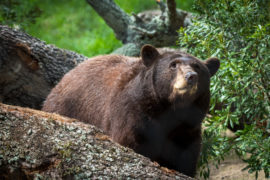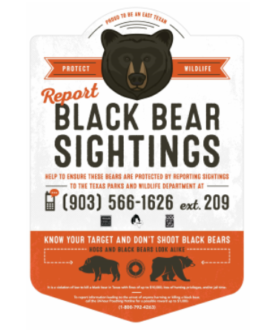See Them, Save Them: Your Visit to the Zoo is Saving Black Bears in Texas
When you think of Texas wildlife, a few animals probably come to mind – armadillos, cougars, longhorns, rattlesnakes…maybe even the whooping crane. Chances are the American black bear wasn’t on your radar, but thanks to its gradual return to Texas it soon will be. Many years ago, four of the 16 subspecies of black bear once roamed the state of Texas. Unfortunately, as the lone star state grew in popularity with settlers throughout the 19th century, the number of black bears began to dwindle as a result of habitat loss and unregulated hunting of the species. By the beginning of the 20th century, seeing a black bear within state lines was considered extremely rare. Today, at least two subspecies of black bear are making their way back into Texas due in large part to the growing populations of black bears in the surrounding states of Louisiana, Arkansas, and Oklahoma, but for those of us living outside of East Texas the black bear remains largely unheard of.

The recent opening of the Hamill Foundation’s Black Bear Exhibit at the Houston Zoo gives Houstonians the opportunity to see the bears up close and learn about what the Zoo is doing to protect them in the wild. The Zoo is participating in state protection planning through the Texas Black Bear Alliance. The alliance is focused on ensuring black bears return to their historic range in Texas by bringing together individuals, organizations, and state and federal government representatives to support the species’ recovery. Because black bears are still considered a rare species in the state, the Texas Parks and Wildlife Department investigates each reported sighting in order to gain a better understanding of the number and rate at which black bears are returning to Texas. Having a clearer picture of the population size allows researchers to create wildlife management plans as well as offer educational outreach activities to community members living near black bear habitat. In conjunction with these efforts the Zoo designed the Texas black bear reporting signs that are used all over the state.

Living outside of the black bears’ home range can make it tricky to know what actions you can take to protect this native Texan. Thankfully, small changes to your everyday routine can make a big difference. Bears need trees to live, so by using less paper or recycled-content paper products, fewer trees are cut down meaning you are contributing to saving black bears in the wild! Consider going paperless for billing or even when purchasing tickets for your next visit to the Zoo. Just last year the Houston Zoo saved 735 mature trees by committing to better paper choices and using digital documents! And remember, every time you visit the Zoo, you’re helping to save black bears like our very own Belle and Willow in the wild. See them, Save them – its as simple as that.
For the 11th annual Wildlife Conservation Gala at the Houston Zoo, we’re shining a spotlight on the species and habitats of the Lone Star State! We’ll come together as Texans to raise the funds our Zoo needs to keep saving Texas wildlife like the American black bear.
